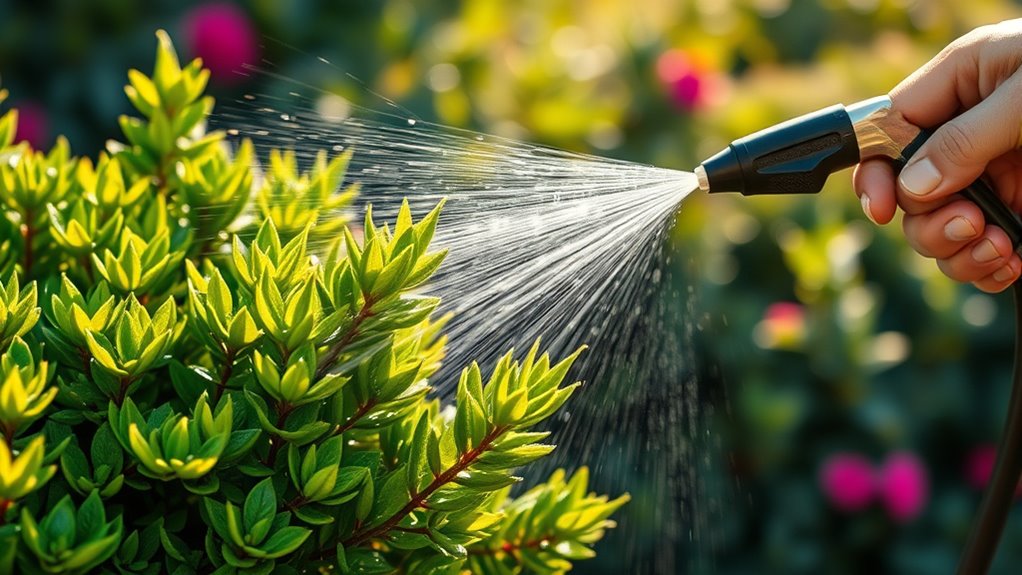To spray corners and edges efficiently, keep your spray gun close to the surface and move slowly in a steady, controlled manner. Adjust your airflow and nozzle for better accuracy, using narrow or adjustable tips to target tight spaces precisely. Practice on scrap first to improve your technique, and use masking tape to protect surrounding areas. Mastering these controls helps you get clean lines and reduce waste—stay tuned to learn more about perfecting your technique.
Key Takeaways
- Use a narrow or detail nozzle to target corners and edges precisely.
- Adjust airflow to enhance spray control in tight spaces and improve accuracy.
- Maintain a steady hand and consistent distance for even coverage along edges.
- Practice slow, deliberate strokes on scrap material to perfect technique.
- Employ masking tape to protect adjacent surfaces and achieve clean, sharp lines.

Have you ever struggled to get paint or cleaning solutions into tight corners and along edges? If so, you’re not alone. These tricky spots can be frustrating, especially when you’re aiming for a smooth, professional finish. The key to tackling these areas effectively lies in precision application and choosing the right nozzle selection. When you focus on these aspects, you’ll find that spraying corners and edges becomes much more manageable, saving you time and effort.
First, understanding precision application is essential. It means controlling the spray so that the paint or cleaning solution lands exactly where you want it—without overspray or drips. To achieve this, you need a steady hand and a good technique. Start by diluting your paint or cleaning solution if necessary; thinner mixtures tend to spray more smoothly into tight spaces. Keep the spray tip close to the surface, but not so close that you risk splattering or uneven coverage. Moving slowly and steadily ensures a more controlled application, helping you avoid messes and touch-ups later.
Additionally, paying attention to airflow control can significantly improve your ability to spray accurately into corners and edges, as it helps regulate the spray pattern and flow rate. Nozzle selection plays a significant role in this process. Different nozzles produce different spray patterns, and choosing the right one can make all the difference. For corners and edges, a narrow or detail nozzle is often best because it provides a focused, fine spray that can reach into those small spaces. Consider nozzles with adjustable settings so you can fine-tune the spray width and flow rate. A smaller or more precise nozzle allows you to target edges without wasting material or covering unintended areas. When you’re working along edges, you might also want a nozzle with a tapered or conical shape, which directs the spray more accurately.
Practicing on a scrap piece before working on your actual project helps you get a feel for nozzle performance and spray control. Hold the spray gun at a consistent distance, and practice slow, deliberate strokes. This helps you develop a steady hand and a better sense of how much material is being applied. Additionally, using masking tape along edges can protect adjacent surfaces, giving you cleaner lines and reducing the need for correction afterward.
Frequently Asked Questions
What Safety Precautions Should I Take While Spraying Corners and Edges?
When spraying corners and edges, you should always wear the appropriate personal protective equipment, like gloves, goggles, and a mask, to prevent exposure. Follow safe handling procedures by reading the product label carefully and working in well-ventilated areas. Keep a safe distance from others, avoid eating or drinking nearby, and wash your hands thoroughly afterward. These precautions help safeguard you from harmful chemicals and ensure safe spraying practices.
Which Types of Sprayers Are Best for Detailed Corner Work?
Think of your sprayer as an artist’s brush for tiny details. Handheld sprayers with precision nozzles are your best tools for detailed corner work. They allow you to navigate tight spaces with control and accuracy, like a surgeon’s steady hand. These sprayers let you target edges and corners without overspray, giving you clean, sharp results. For delicate, intricate work, nothing beats the finesse of a good handheld sprayer with precision nozzles.
How Can I Avoid Overspray on Adjacent Surfaces?
To avoid overspray on adjacent surfaces, you should use edge masking tape to protect areas you don’t want painted. Adjust your spray pattern to a narrower setting for better control, and keep the spray gun perpendicular to the surface. Move your hand steadily and steadily, maintaining a consistent distance. This technique guarantees precise application, reduces overspray, and keeps adjacent surfaces clean and paint-free.
What Maintenance Is Needed for Sprayers Used on Edges?
You might think maintenance is complicated, but it’s straightforward. Regularly check your sprayer for proper calibration to guarantee even application, especially on edges. If you notice uneven spray or clogging, replace the nozzles promptly. Clean your sprayer thoroughly after each use to prevent buildup, and periodically verify calibration settings. This routine keeps your sprayer functioning efficiently, reduces waste, and ensures precise coverage on edges without unnecessary overspray.
Are There Eco-Friendly Options for Spraying Corners and Edges?
Yes, you can choose eco-friendly options for spraying corners and edges. Opt for biodegradable sprayers that break down naturally and use eco-friendly solvents that minimize environmental impact. These alternatives help reduce chemical runoff and pollution. By selecting biodegradable sprayers and eco-friendly solvents, you guarantee your spraying practices are sustainable and safer for the environment, all while maintaining effective coverage in those hard-to-reach corners and edges.
Conclusion
Now that you know how to spray corners and edges efficiently, you’ll save time and achieve a flawless finish. Imagine Sarah, a homeowner, finishing her living room in half the usual time and with perfect lines, feeling proud of her work. With these techniques, you can transform any space quickly and confidently. Don’t let tricky corners hold you back—master the skill, and enjoy the satisfaction of a professional-looking result every time.









